Direct Laser Interference Patterning: Tailoring of Contact Area for Frictional and Antibacterial Properties
Abstract
:1. Introduction
2. Results and Discussion
2.1. Physical Principle of DLIP

2.2. Surface Patterns for an Improved Tribological Performance
2.2.1. How to Achieve Quasi-Periodic Penrose-Like Surface Patterns
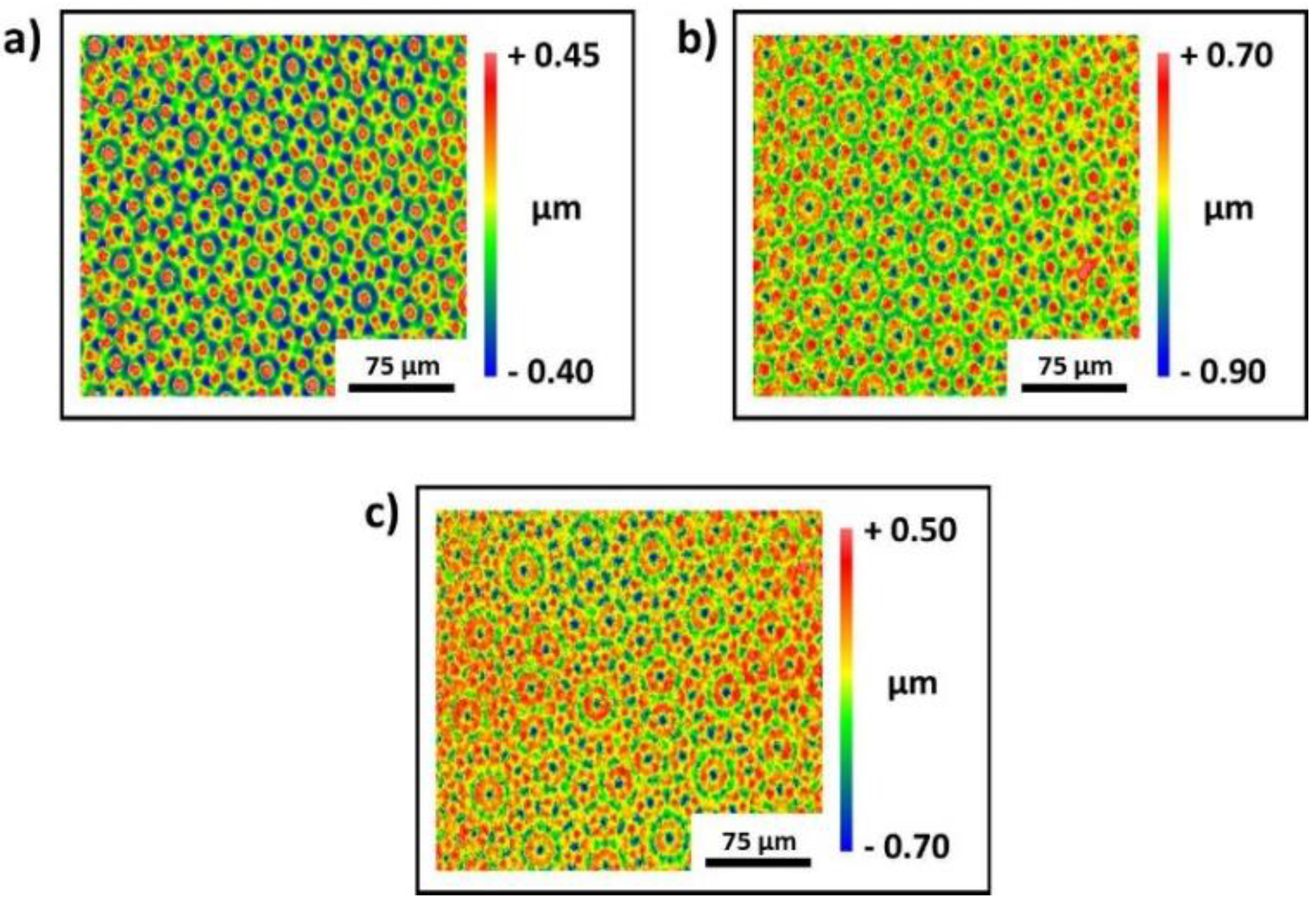
2.2.2. Effects under Dry Friction
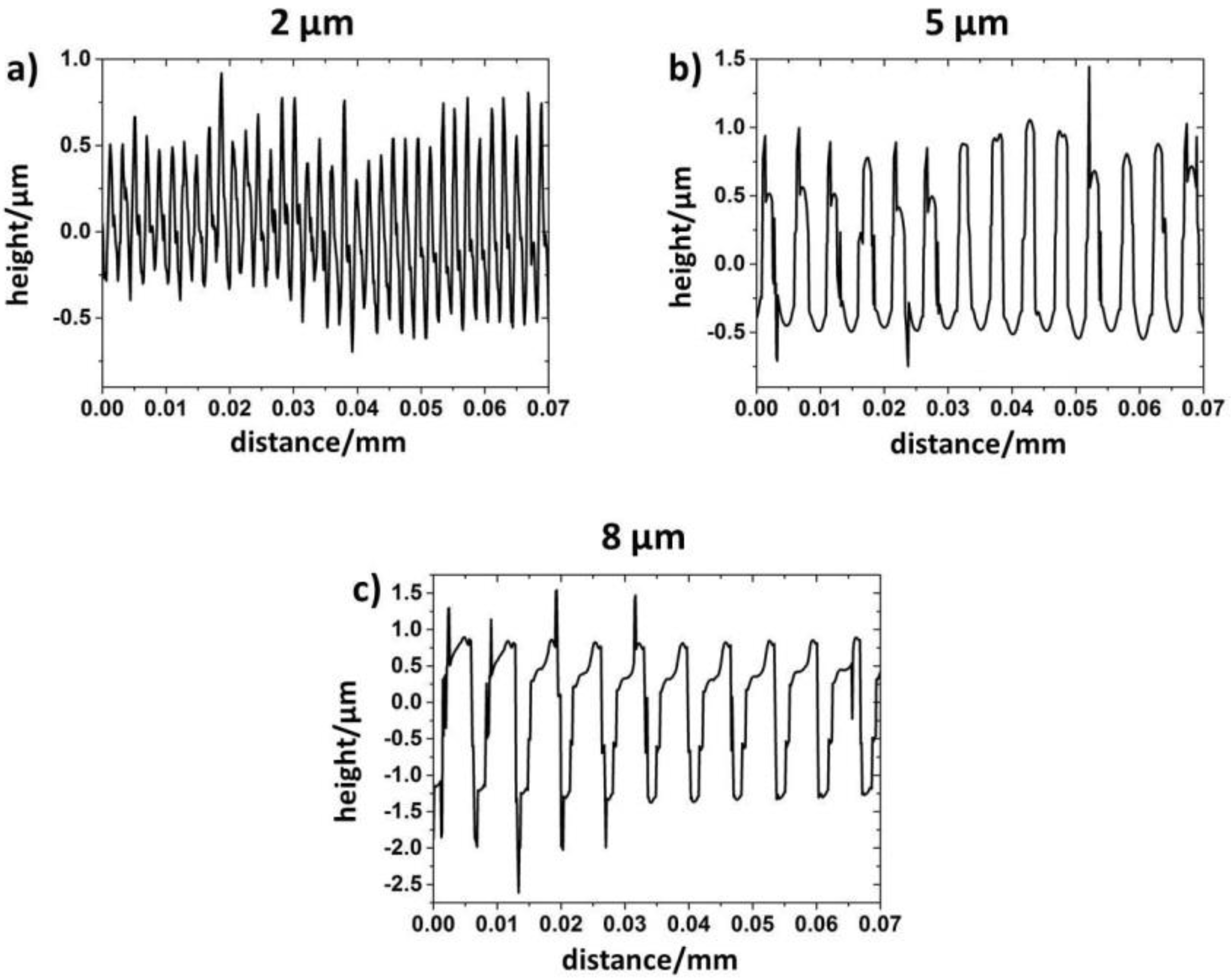
| Sample | H/µm | Rq/nm | Rsk |
|---|---|---|---|
| Polished reference | 0.030 ± 0.005 | 20 ± 3 | −1.44 ± 0.33 |
| Line pattern P = 2 µm | 1.58 ± 0.27 | 547 ± 56 | 0.73 ± 0.16 |
| Line pattern P = 5 µm | 1.88 ± 0.34 | 579 ± 116 | 0.65 ± 0.13 |
| Line pattern P = 7 µm | 2.98 ± 0.37 | 936 ± 89 | 0.25 ± 0.09 |
| Line pattern P = 8 µm | 2.87 ± 0.36 | 978 ± 76 | 0.53 ± 0.06 |

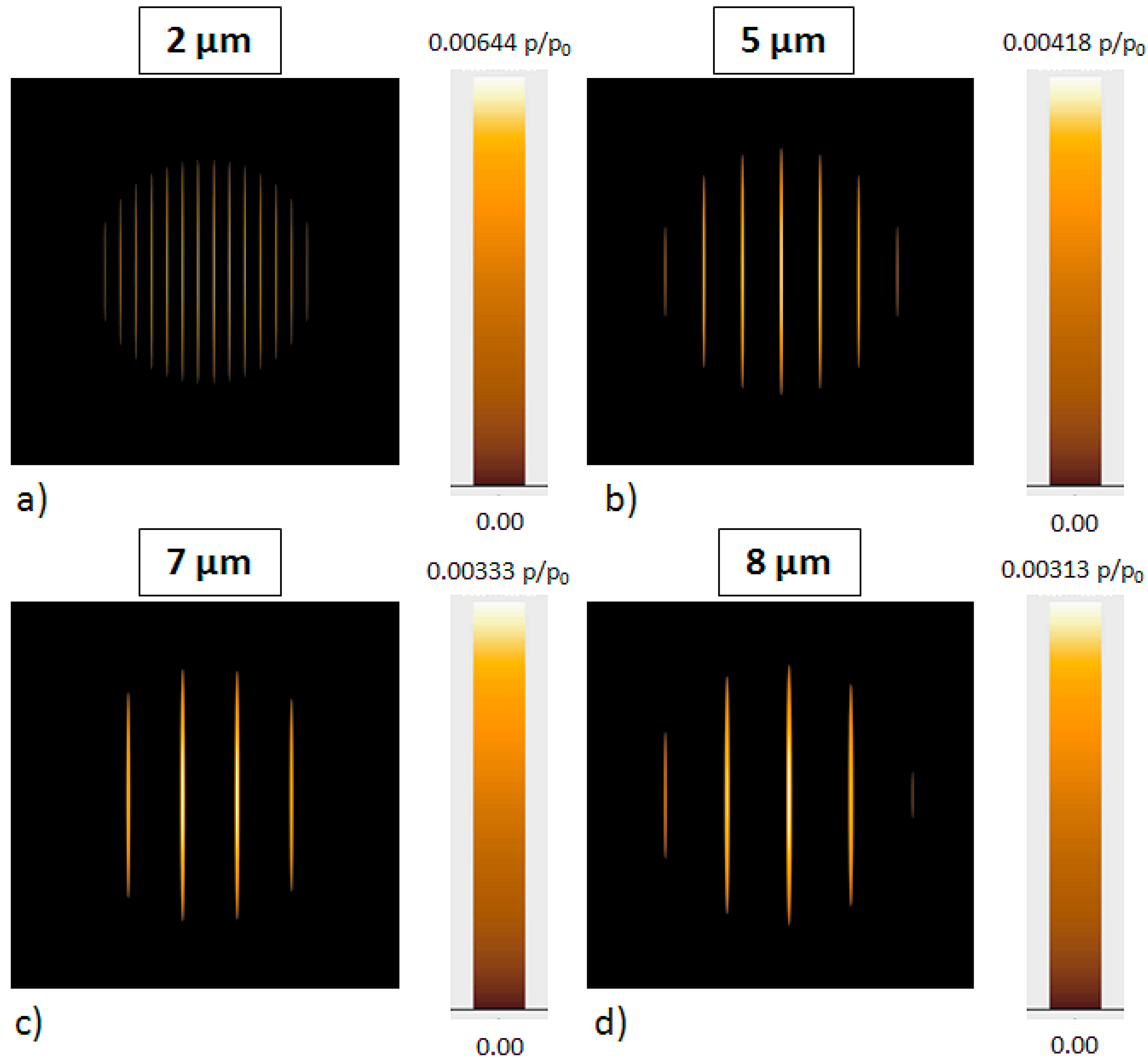
| Periodicity/µm | Number of Asperities | Contact Area/µm2 |
|---|---|---|
| 2 | 14 | 29.48 |
| 5 | 7 | 44.38 |
| 7 | 4 | 50.58 |
| 8 | 5 | 55.81 |
2.3. Antibacterial Surface Structures for Implant Materials
2.3.1. DLIP to Investigate Bacterial Killing
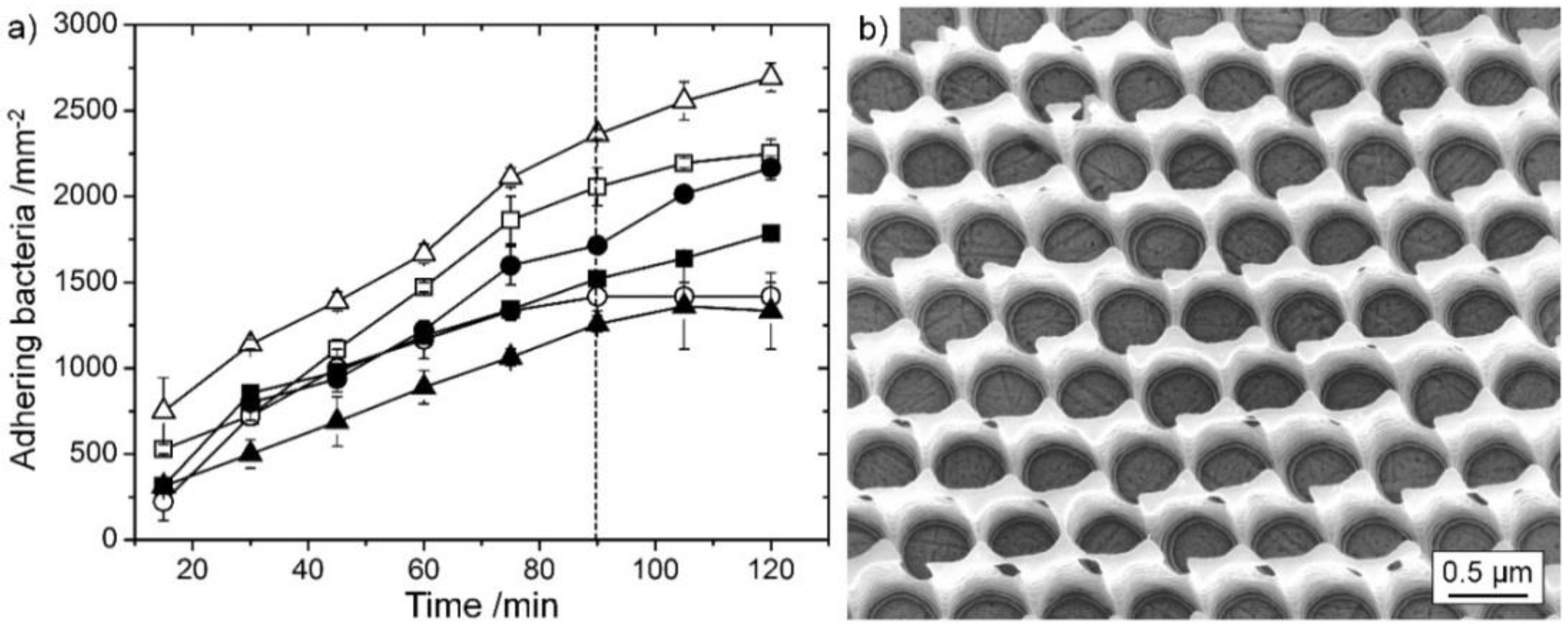
2.3.2. DLIP Induces Antibacterial Surface Effects
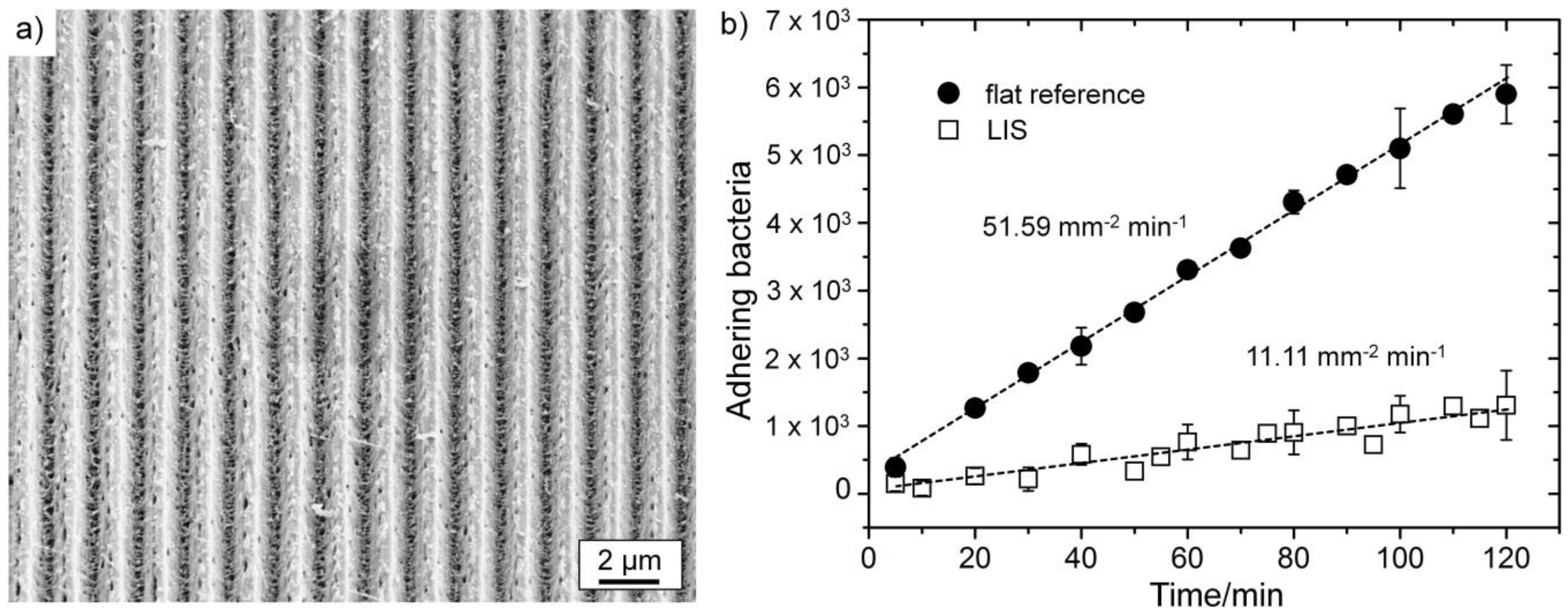
3. Experimental Section
3.1. Materials
3.2. Laser Interference Patterning (DLIP)

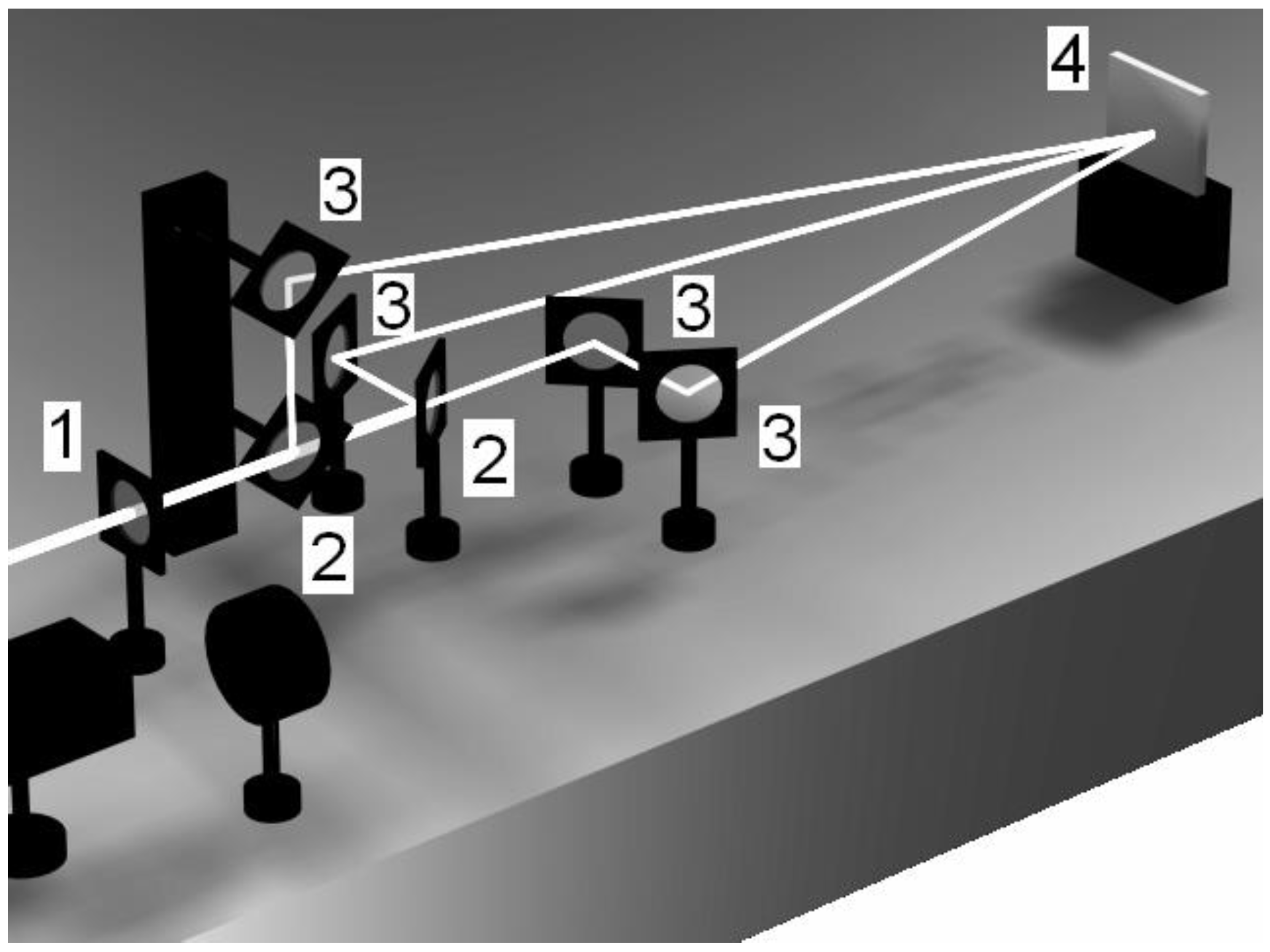
3.3. Tribological Experiments
4. Conclusions
Acknowledgments
Author Contributions
Conflicts of Interest
References
- Liu, Y.; Tang, J.; Wang, R.; Lu, H.; Li, L.; Kong, Y.; Qi, K.; Xin, J.H. Artificial lotus leaf structures from assembling carbon nanotubes and their applications in hydrophobic textiles. J. Mater. Chem. 2007, 17, 1071–1078. [Google Scholar] [CrossRef]
- Lee, H.; Lee, B.P.; Messersmith, P.B. A reversible wet/dry adhesive inspired by mussels and geckos. Nature 2007, 448, 338–341. [Google Scholar] [CrossRef] [PubMed]
- Gao, X.; Yan, X.; Yao, X.; Xu, L.; Zhang, K.; Zhang, J.; Yang, B.; Jiang, L. The dry-style antifogging properties of mosquito compound eyes and artificial analogues prepared by soft lithography. Adv. Mater. 2007, 19, 2213–2217. [Google Scholar] [CrossRef]
- Gao, X.; Jiang, L. Biophysics: Water-Repellent Legs of Water Striders. Nature 2004, 432, 36. [Google Scholar] [CrossRef] [PubMed]
- Potyrailo, R.A.; Ghiradella, H.; Vertiatchikh, A.; Dovidenko, K.; Cournoyer, J.R.; Olson, E. Morpho butterfly wing scales demonstrate highly selective vapour response. Nat. Photonics 2007, 1, 123–128. [Google Scholar] [CrossRef]
- Brakefield, P.M.; French, V. Butterfly wings: The evolution of development of colour patterns. BioEssays 1999, 21, 391–401. [Google Scholar] [CrossRef]
- Eisner, T.; Alsop, R.; Ettershank, G. Adhesiveness of spider silk. Science 1964, 146, 1058–1061. [Google Scholar] [CrossRef] [PubMed]
- Bhushan, B. Biomimetics: Lessons from Nature—An Overview. Philos. Trans. A Math. Phys. Eng. Sci. 2009, 367, 1445–1486. [Google Scholar] [CrossRef] [PubMed]
- Kwak, M.K.; Pang, C.; Jeong, H.E.; Kim, H.N.; Yoon, H.; Jung, H.S.; Suh, K.Y. Towards the next level of bioinspired dry adhesives: New Designs and Applications. Adv. Funct. Mater. 2011, 21, 3606–3616. [Google Scholar] [CrossRef]
- Xia, F.; Jiang, L. Bio-inspired, smart, multiscale interfacial materials. Adv. Mater. 2008, 20, 2842–2858. [Google Scholar] [CrossRef]
- Sun, T.; Feng, L.; Gao, X.; Jiang, L. Bioinspired surfaces with special wettability. Acc. Chem. Res. 2005, 38, 644–652. [Google Scholar] [CrossRef] [PubMed]
- Barthlott, W.; Neinhuis, C. Purity of the sacred lotus, or escape from contamination in biological surfaces. Planta 1997, 202, 1–8. [Google Scholar] [CrossRef]
- Vukusic, P.; Sambles, J.R.; Lawrence, C.R. Structural colour: Colour Mixing in Wing Scales of a Butterfly. Nature 2000, 404, 457. [Google Scholar] [CrossRef] [PubMed]
- Hasan, J.; Crawford, R.J.; Ivanova, E.P. Antibacterial surfaces: The Quest for a New Generation of Biomaterials. Trends Biotechnol. 2013, 31, 295–304. [Google Scholar] [CrossRef] [PubMed]
- Liu, K.; Jiang, L. Bio-inspired design of multiscale structures for function integration. Nano Today 2011, 6, 155–175. [Google Scholar] [CrossRef]
- Ivanova, E.P.; Hasan, J.; Webb, H.K.; Truong, V.K.; Watson, G.S.; Watson, J.A.; Baulin, V.A.; Pogodin, S.; Wang, J.Y.; Tobin, M.J.; et al. Natural bactericidal surfaces: Mechanical Rupture of Pseudomonas Aeruginosa Cells by Cicada Wings. Small 2012, 8, 2489–2494. [Google Scholar] [CrossRef] [PubMed]
- Ishihara, H.; Yamagami, H.; Sumiya, T.; Okudera, M.; Inada, A.; Terada, A.; Nakamura, T. Contact start/stop characteristics on photolithographic magnetic recording media. Wear 1994, 172, 65–72. [Google Scholar] [CrossRef]
- Ranjan, R; Lambeth, D.N.; Tromel, M.; Goglia, P.; Li, Y. Laser texturing for low-flying-height media. J. Appl. Phys. 1991, 69, 5745–5747. [Google Scholar] [CrossRef]
- Rapoport, L.; Moshkovich, A.; Perfilyev, V.; Lapsker, I.; Halperin, G.; Itovich, Y.; Etsion, I. Friction and wear of MoS2 films on laser textured steel surfaces. Surf. Coat. Technol. 2008, 202, 3332–3340. [Google Scholar] [CrossRef]
- Nosonovsky, M.; Bhushan, B. Multiscale friction mechanisms and hierarchical surfaces in nano-and bio-tribology. Mater. Sci. Eng. R Rep. 2007, 58, 162–193. [Google Scholar] [CrossRef]
- Chilamakuri, S.K.; Bhushan, B. Optimization of asperities for laser-textured magnetic disk surfaces. Tribol. Trans. 1997, 40, 303–311. [Google Scholar] [CrossRef]
- Xing, Y.; Deng, J.; Feng, X.; Yu, S. Effect of laser surface texturing on Si 3 N 4/TiC ceramic sliding against steel under dry friction. Mater. Des. 2013, 52, 234–245. [Google Scholar] [CrossRef]
- Borghi, A.; Gualtieri, E.; Marchetto, D.; Moretti, L.; Valeri, S. Tribological effects of surface texturing on nitriding steel for high-performance engine applications. Wear 2008, 265, 1046–1051. [Google Scholar] [CrossRef]
- Wang, Z.; Zhao, Q.; Wang, C.; Zhang, Y. Modulation of dry tribological property of stainless steel by femtosecond laser surface texturing. Appl. Phys. A 2015, 119, 1155–1163. [Google Scholar] [CrossRef]
- Gachot, C.; Rosenkranz, A.; Reinert, L.; Ramos-Moore, E.; Souza, N.; Müser, M.H.; Mücklich, F. Dry friction between laser-patterned surfaces: Role of Alignment, Structural Wavelength and Surface Chemistry. Tribol. Lett. 2013, 49, 193–202. [Google Scholar] [CrossRef]
- Prodanov, N.; Gachot, C.; Rosenkranz, A.; Mücklich, F.; Müser, M.H. Contact mechanics of laser-textured surfaces. Tribol. Lett. 2013, 50, 41–48. [Google Scholar] [CrossRef]
- Rosenkranz, A.; Reinert, L.; Gachot, C.; Mücklich, F. Alignment and wear debris effects between laser-patterned steel surfaces under dry sliding conditions. Wear 2014, 318, 49–61. [Google Scholar] [CrossRef]
- He, B.; Chen, W.; Wang, Q.J. Surface texture effect on friction of a microtextured poly (dimethylsiloxane) (PDMS). Tribol. Lett. 2008, 31, 187–197. [Google Scholar] [CrossRef]
- Yu, C.; Yu, H.; Liu, G.; Chen, W.; He, B.; Wang, Q.J. Understanding topographic dependence of friction with micro-and nano-grooved surfaces. Tribol. Lett. 2014, 53, 145–156. [Google Scholar] [CrossRef]
- Öner, D.; McCarthy, T.J. Ultrahydrophobic surfaces. Effects of topography length scales on wettability. Langmuir 2000, 16, 7777–7782. [Google Scholar] [CrossRef]
- Jeong, H.E.; Lee, J.K.; Kim, H.N.; Moon, S.H.; Suh, K.Y. A nontransferring dry adhesive with hierarchical polymer nanohairs. Proc. Natl. Acad. Sci. USA 2009, 106, 5639–5644. [Google Scholar] [CrossRef] [PubMed]
- Mücklich, F.; Lasagni, A.F.; Daniel, C. Laser Interference Metallurgy-using interference as a tool for micro/nano structuring. Int. J. Mater. Res. 2006, 97, 1337–1344. [Google Scholar] [CrossRef]
- Lasagni, A.F.; D’Alessandria, M.; Giovanelli, R.; Mücklich, F. Advanced design of periodical architectures in bulk metals by means of Laser Interference Metallurgy. Appl. Surf. Sci. 2007, 254, 930–936. [Google Scholar] [CrossRef]
- Mathews, S.; Hans, M.; Mücklich, F.; Solioz, M. Contact killing of bacteria on copper is suppressed if bacterial-metal contact is prevented and is induced on iron by copper ions. Appl. Environ. Microbiol. 2013, 79, 2605–2611. [Google Scholar] [CrossRef]
- Rosenkranz, A.; Heib, T.; Gachot, C.; Mücklich, F. Oil film lifetime and wear particle analysis of laser-patterned stainless steel surfaces. Wear 2015, 334, 1–12. [Google Scholar] [CrossRef]
- Lasagni, A.F. Advanced Design of Periodical Structures by Laser Interference Metallurgy in the Micro/Nano Scale on Macroscopic Areas. Ph.D. Thesis, Saarland University, Saarbruecken, Germany, 2006. [Google Scholar]
- Fowell, M.T.; Pegg, I.G.; Olver, A.V.; Gosman, A.D.; Spikes, H.A. Entrainment and inlet suction: Two Mechanisms of Hydrodynamic Lubrication in Textured Bearings. J. Tribol. 2007, 129, 336–347. [Google Scholar] [CrossRef]
- Olver, A.V.; Fowell, M.T.; Spikes, H.A.; Pegg, I.G. “Inlet suction”, a load support mechanism in non-convergent, pocketed, hydrodynamic bearings. J. Eng. Tribol. 2006, 220, 105–108. [Google Scholar] [CrossRef]
- Tian, H.; Saka, N.; Suh, N.P. Boundary lubrication studies on undulated titanium surfaces. Tribol. Trans. 1989, 32, 289–296. [Google Scholar] [CrossRef]
- Saka, N.; Tian, H.; Suh, N.P. Boundary lubrication of undulated metal surface at elevated temperatures. Tribol. Trans. 1989, 32, 389–395. [Google Scholar] [CrossRef]
- Dumitru, G.; Romano, V.; Weber, H.P.; Haefke, H.; Gerbig, Y.; Pflueger, E. Laser microstructuring of steel surfaces for tribological applications. J. Appl. Phys. A 2000, 70, 485–487. [Google Scholar] [CrossRef]
- Andersson, P.; Koskinen, J.; Varjus, S.; Gerbig, Y.; Haefke, H.; Georgiou, S.; Zhmud, B.; Buss, W. Microlubrication effect by laser-textured steel surfaces. Wear 2007, 262, 369–379. [Google Scholar] [CrossRef]
- Song, Y.; Premchandran, N.R.; Zou, M.; Wang, Y.A. Adhesion and friction properties of micro/nano-engineered superhydrophobic/hydrophobic surfaces. Thin Solid Films 2010, 518, 3801–3807. [Google Scholar] [CrossRef]
- Gebeshuber, I.C. Biotribology inspires new technologies. Nano Today 2007, 2, 30–37. [Google Scholar] [CrossRef]
- Filippov, A.E.; Vanossi, A.; Urbakh, M. Origin of friction anisotropy on a quasicrystal surface. Phys. Rev. Lett. 2010, 104, 074302. [Google Scholar] [CrossRef] [PubMed]
- Park, J.Y.; Thiel, P.A. Atomic scale friction and adhesion properties of quasicrystal surfaces. J. Phys. Condens. Matter 2008, 20, 314012. [Google Scholar] [CrossRef]
- Menezes, P.L.; Kishore; Kailas, S.V. Effect of roughness parameter and grinding angle on coefficient of friction when sliding Al-Mg alloy over EN8 steel. J. Tribol. 2004, 128, 697–704. [Google Scholar] [CrossRef]
- Menezes, P.L.; Kishore; Kailas, S.V. Studies on friction and transfer layer: Role of Surface Texture. Tribol. Lett. 2006, 24, 265–273. [Google Scholar] [CrossRef]
- ZoBell, C.E. The effect of solid surfaces upon bacterial activity. J. Bacteriol. 1943, 46, 36–56. [Google Scholar]
- Costerton, J.W.; Stewart, P.S.; Greenberg, E.P. Bacterial biofilms: A Common Cause of Persistent Infections. Science 1999, 284, 1318–1322. [Google Scholar] [CrossRef] [PubMed]
- Campoccia, D.; Montanaro, L.; Arciola, C.R. A review of the biomaterials technologies for infection-resistant surfaces. Biomaterials 2013, 34, 8533–8554. [Google Scholar] [CrossRef] [PubMed]
- Glinel, K.; Thebault, P.; Humblot, V.; Pradier, C.M.; Jouenne, T. Antibacterial surfaces developed from bio-inspired approaches. Acta Biomater. 2012, 8, 1670–1684. [Google Scholar] [CrossRef] [PubMed]
- Ivanova, E.P.; Hasan, J.; Webb, H.K.; Gervinskas, G.; Juodkazis, S.; Truong, V.K.; Wu, A.H.F.; Lamb, R.N.; Baulin, V.A.; Watson, G.S.; et al. Bactericidal activity of black silicon. Nat. Commun. 2013, 4, 1–7. [Google Scholar] [CrossRef] [PubMed]
- Sengstock, C.; Lopian, M.; Motemani, Y.; Borgmann, A.; Khare, C.; Buenconsejo, P.J.S.; Schildhauer, T.A.; Ludwig, A.; Köller, M. Structure-related antibacterial activity of a titanium nanostructured surface fabricated by glancing angle sputter deposition. Nanotechnology 2014, 25, 195101–195112. [Google Scholar] [CrossRef] [PubMed]
- Ploux, L.; Anselme, K.; Dirani, A.; Ponche, A. Opposite responses of cells and bacteria to micro/nanopatterned surfaces prepared by pulsed plasma polymerization and UV-irradiation. Langmuir 2009, 25, 8161–8169. [Google Scholar] [CrossRef] [PubMed]
- Anselme, K.; Davidson, P.; Popa, A.M.; Giazzon, M.; Liley, M.; Ploux, L. The interaction of cells and bacteria with surfaces structured at the nanometre scale (Review). Acta Biomater. 2010, 6, 3824–3846. [Google Scholar] [CrossRef] [PubMed]
- Jullien, C.; Benezech, T.; le Gentil, C.; Boulange-Petermann, L.; Dubois, P.E.; Tissier, J.P.; Traisnel, M.; Faille, C. Physico-chemical and hygienic property modification of stainless steel surfaces induced by conditioning with food and detergent. Biofouling 2008, 24, 163–172. [Google Scholar] [CrossRef] [PubMed]
- Bazaka, K.; Jacob, M.V.; Crawford, R.J.; Ivanova, E.P. Efficient surface modification of biomaterial to prevent biofilm formation and the attachment of microorganisms. Appl. Microbiol. Biotechnol. 2012, 95, 299–311. [Google Scholar] [CrossRef] [PubMed]
- Lewandowska, Ż.; Piszczek, P.; Radtke, A.; Jędrzejewski, T.; Kozak, W.; Sadowska, B. The evaluation of the impact of titania nanotube covers morphology and crystal phase on their biological properties. J. Mater. Sci. Mater. Med. 2015, 26, 1–12. [Google Scholar] [CrossRef] [PubMed]
- Wagner, K.; Friedrich, S.; Stang, C.; Bley, T.; Schilling, N.; Bieda, M.; Lasagni, A.; Boschke, E. Initial phases of microbial biofilm formation on opaque, innovative anti-adhesive surfaces using a modular microfluidic system. Eng. Life Sci. 2013, 14, 76–84. [Google Scholar] [CrossRef]
- Valle, J.; Burgui, S.; Langheinrich, D.; Gil, C.; Solano, C.; Toledo-Arana, A.; Helbig, R.; Lasagni, A.; Lasa, I. Evaluation of Surface Microtopography Engineered by Direct Laser Interference for Bacterial Anti-Biofouling. Macromol. Biosci. 2015, 15, 1060–1069. [Google Scholar] [CrossRef] [PubMed]
- ATS Labs. Test Method for the Continuous Reduction of Bacterial Contamination on Copper Alloy Surfaces; US Environmental Protection Agency: Washington, DC, USA, 2005.
- Whitehead, K.A.; Verran, J. The effect of surface topography on the retention of microorganisms. Food Bioprod. Proc. 2006, 84, 253–259. [Google Scholar] [CrossRef]
© 2016 by the authors; licensee MDPI, Basel, Switzerland. This article is an open access article distributed under the terms and conditions of the Creative Commons by Attribution (CC-BY) license (http://creativecommons.org/licenses/by/4.0/).
Share and Cite
Rosenkranz, A.; Hans, M.; Gachot, C.; Thome, A.; Bonk, S.; Mücklich, F. Direct Laser Interference Patterning: Tailoring of Contact Area for Frictional and Antibacterial Properties. Lubricants 2016, 4, 2. https://doi.org/10.3390/lubricants4010002
Rosenkranz A, Hans M, Gachot C, Thome A, Bonk S, Mücklich F. Direct Laser Interference Patterning: Tailoring of Contact Area for Frictional and Antibacterial Properties. Lubricants. 2016; 4(1):2. https://doi.org/10.3390/lubricants4010002
Chicago/Turabian StyleRosenkranz, Andreas, Michael Hans, Carsten Gachot, Adrian Thome, Simon Bonk, and Frank Mücklich. 2016. "Direct Laser Interference Patterning: Tailoring of Contact Area for Frictional and Antibacterial Properties" Lubricants 4, no. 1: 2. https://doi.org/10.3390/lubricants4010002






